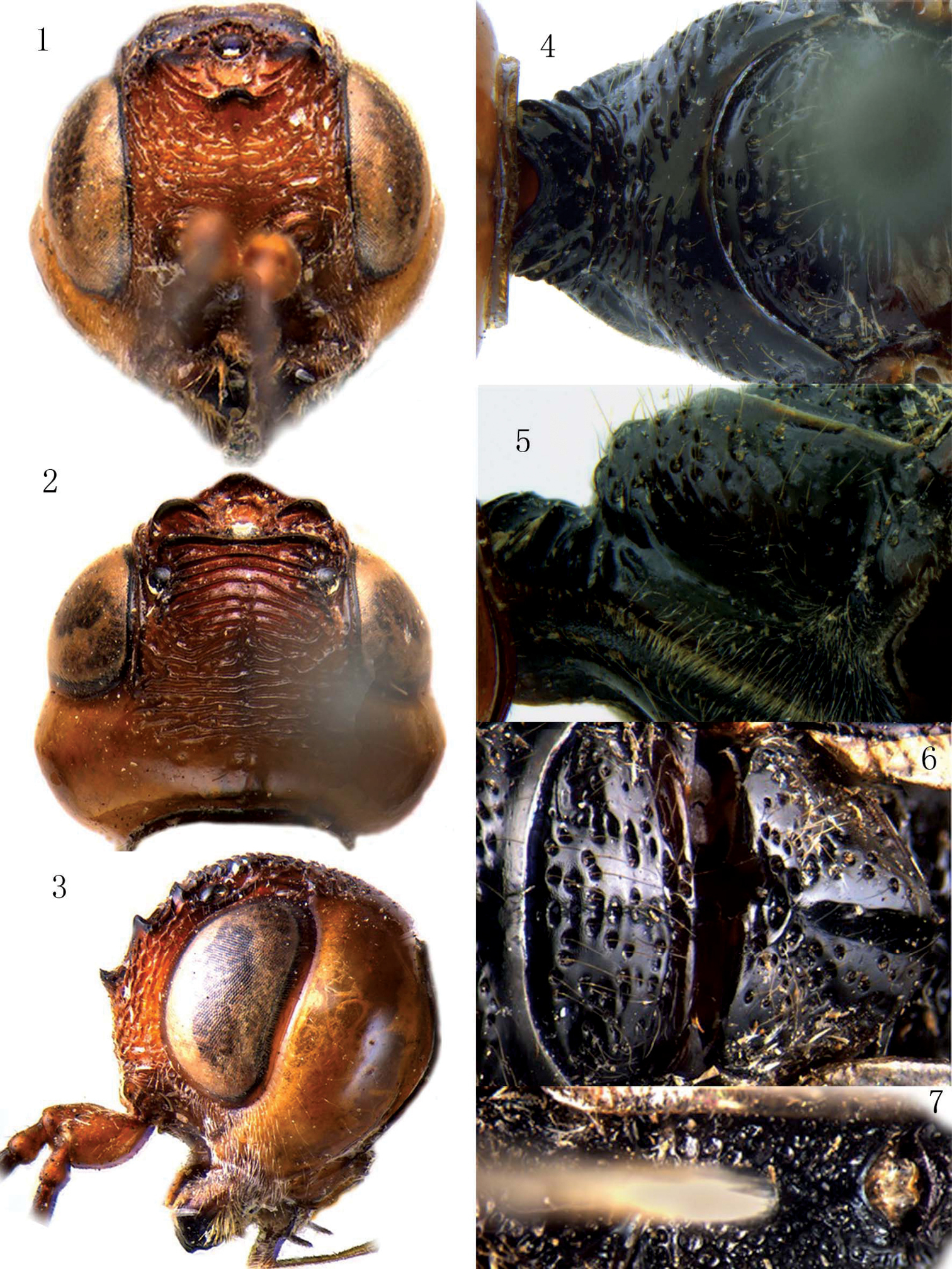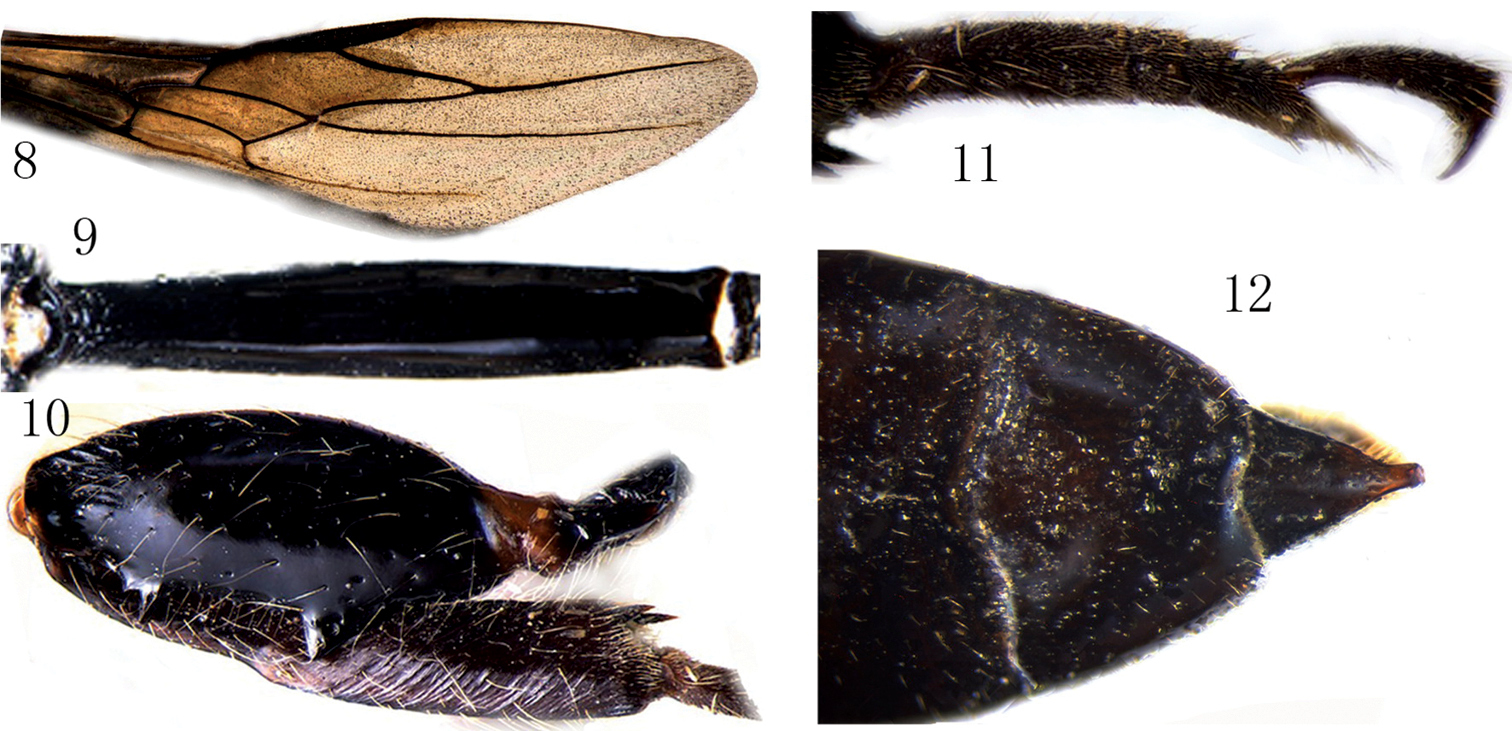(C) 2010 Chun-dan Hong. This is an open access article distributed under the terms of the Creative Commons Attribution License, which permits unrestricted use, distribution, and reproduction in any medium, provided the original author and source are credited.
For reference, use of the paginated PDF or printed version of this article is recommended.
A new species of Megischus Brullé from China, Megischus aplicatus sp. n., is described and illustrated. A key to the Chinese species of Megischus is added. The holotype is deposited in the Parasitic Hymenoptera Collection of Zhejiang University, Hangzhou.
Hymenoptera, Stephanidae, Megischus, new species, China
The genus Megischus Brullé, 1846 (Hymenoptera: Stephanidae) is cosmopolitan, but most species are known from the Indo-Australian region (
The genus Megischus
is characterized mainly as follows: body medium sized to large; temple
without conspicuous ivory stripe along outer orbit; forewing with four
or more closed cells; first subdiscal cell of fore wing comparatively
slender and vein 2-1A completely pigmented; vein 1-M of fore wing
2.2–8.0 times as long as vein 1-SR; hind femur with two large ventral
teeth; hind tarsus of female 3-segmented and of male 5-segmented;
ovipositor sheath with an ivory subapical band (
The specimen was collected in Hubei Province, China, and is deposited in the Parasitic Hymenoptera Collection of Zhejiang University, Hangzhou (ZJUH).
Morphological terminology, including the wing venation system, follows
| 1 | Gena narrowly rounded medially behind eye in dorsal view (Fig. 18 in |
Megischus chaoi van Achterberg, 2004 |
| – | Temple medially roundly convex behind eye in dorsal view (Fig. 25 in |
2 |
| 2 | Temple slightly convex behind eye (Fig. 25 in |
Megischus ptosimae Chao, 1964 |
| – | Temple distinctly convex behind eye (Fig. 3); pronotal fold absent (Fig. 4–5); vein 1-M of fore wing about 2.2 times as long as vein 1-SR and 0.9 times vein m-cu (Fig. 8); first tergite largely smooth and shiny dorsally (Fig. 9); head largely orange brown; widened part of hind tibia of male nearly straight ventrally (Fig. 10) | Megischus aplicatus sp. n. |
urn:lsid:zoobank.org:act:65A9A7F9-83C9-4D9E-ADC5-D058A6C44656
Figs 1–12Length of body 25.7 mm, and of fore wing 13.9 mm.
Antenna with 41 segments; first antennal segment 1.6 times as long as wide and twice as long as second segment, third segment 2.4 times as long as wide and 0.8 times as fourth segment; frons (Fig. 1) strongly rugose, rugae laterally curved upwards; three anterior coronal teeth large, two posterior ones connected and somewhat sinuate; vertex (Fig. 2) with 4 strongly curved carinae, followed by irregularly transversely striate area, striae coarser laterally and largely interrupted medio-dorsally, resulting in a more or less longitudinal impression, sculpture disappearing near occipital carina, leaving a narrow smooth area; area along inner orbit with one distinct longitudinal carina on each side; temple (Fig. 3) largely smooth and shiny, roundly convex occipital carina strongly developed.
Megischus aplicatus sp. n. ♂. 1 head, anterior view 2 head, dorsal view 3 head, lateral view 4 pronotum, dorsal view 5 pronotum, lateral view 6 mesoscutum and scutellum 7 propodeum.
Neck (Fig. 4) rather short and robust, medio-dorsally rather shallowly concave, laterally with pairs of strong carinae, neck at much lower level than middle part of pronotum; pronotal fold absent (Fig. 4–5); middle and posterior part of pronotum strongly punctate dorsally and laterally, punctures bearing setae and with smooth interspaces; lateral oblique groove of pronotum smooth and shallowly impressed (Fig. 5), ventral area below it punctate and setose; propleuron coriaceous and densely setose; prosternum irregularly punctate, punctures posteriorly more dense and with setae; mesoscutum (Figs 6) shiny, foveolate and with smooth interspaces, laterally foveolate, largely coalescent, areolate; notauli and median groove indistinct and formed by some small foveolae; axillae foveolate and setose; scutellum (Fig. 6) medially largely smooth and laterally sparsely foveolate; mesopleuron robust, dorsal part finely setose, convex part evenly punctate and with smooth interspaces, each puncture bearing a whitish seta, metapleuron medially distinctly convex and densely foveolate-rugose, with fine setosity, ventral part largely smooth and with both dorsal anterior depression and ventral one rather deep; propodeum (Fig. 7) densely reticulate-foveolate.
Fore wing (Fig. 8): vein 1-M distinctly curved, 2.2 times as long as vein 1-SR and 0.9 times vein m-cu; vein 2-SR 1.1 times as long as vein r; vein r ends 0.5 times length of pterostigma behind level of apex of pterostigma; vein 1-SR 0.95 times as long as parastigmal vein; vein cu-a postfurcal and subvertical; vein 3-CU1 largely nebulous.
Megischus aplicatus sp. n. ♂. 8 fore wing 9 first tergite 10 hind femur and tibia 11 hind tarsus 12 pygidial process.
Hind coxa rather strong, annular, coarsely punctate and setose; hind femur (Fig. 10) sparsely punctate and with whitish setae, area in between smooth and shiny, ventrally with two large teeth and some denticles in between; hind tibia robust, ventrally mostly straight and 1.3 times as long as hind femur, basal narrow part about 0.6 times as long as widened part, outer side obliquely carinate, inner side apically densely setose; hind basitarsus (Fig. 11) subparallel-sided, 3.5 times as long as its apical width and 4.7 times as long as second tarsus.
First tergite largely smooth and shiny (Fig. 9), 5.2 times as long as its maximum width, 1.4 times as long as second tergite and 0.5 times as long as remainder of tergites; remainder of tergites smooth; pygidial process (Fig. 12) distinct and tubular apically.
Head orange brown; pronotum, mesosoma, first tergite and hind legs largely dark brown or black; metasoma except first tergite brown to blackish; wing membrane light brownish, wing venation and pterostigma dark brown.
Holotype male, China: Hubei, Shennongjia National Nature Reserve, viii.1982, Coll. Shi Shang-bo, No. 870112 (ZJUH).
Unknown.
Unknown.
China (Hubei).
The new species runs in the key by
The name of this species derives from the Latin “a-” and “plicatus” which means without fold, because this species has no pronotal fold on the pronotum.
We are grateful to Prof. Jun-hua He and Prof. Xue-xin Chen of Zhejiang University for their generous loan of the specimens of Stephanidae.








